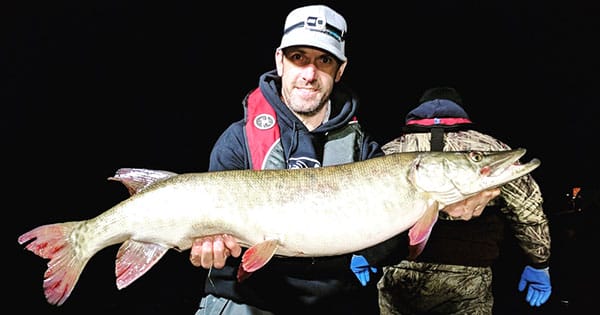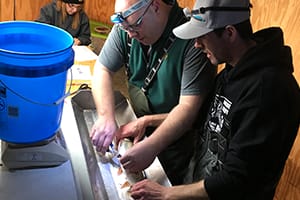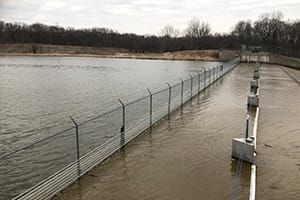
USA member Dave Halverson holds a healthy Iowa muskie captured for tagging and future study.
Union Sportsmen’s Alliance member Dave Halverson is helping complete ground-breaking fishery research that could help other anglers catch more muskies and walleyes on reservoirs across the continent.
Halverson, 35, hails from Truro, Iowa, a short cast south of Des Moines. A member of the International Brotherhood of Electrical Workers (IBEW) Local 347, the hard-working electrician has been charged up over muskies for years.
“I love their absolute power and elusiveness,” he explained. “The feeling I get from watching a giant muskie chase down and inhale a lure at boatside is incomparable—and watching the fish swim away after release keeps me coming back.”
Halverson’s passion for muskies led him to help launch the Mid-Iowa chapter of Muskies, Inc., a national nonprofit dedicated to improving muskie fishing.
“One of our main goals is promoting muskie conservation through catch-and-release,” he said. “We educate people that these fish are much better off in the water, where others can enjoy them for years to come, than they are on a dinner plate or a wall.”

Halverson assists researchers inside a tagging station.
But Halverson didn’t stop there. He and fellow club members donated time and financial support to a 5-year fishery research study by the Iowa Department of Natural Resources, U.S. Army Corps of Engineers and Iowa State University that could have implications for muskie and walleye management across the country.
“We provided volunteers to help biologists capture, tag and release fish this spring,” Halverson said. “To date, we’ve volunteered approximately 35 hours, but expect that figure to reach 200 hours by the project’s completion. We also secured a $2,000 Muskies, Inc. grant and used it to purchase 1,200 tags for the study.”
According to Iowa DNR biologist Ben Dodd, the research targets the dynamics of fish loss in man-made reservoirs due to escapement over dam spillways and is being conducted on central Iowa’s Brushy Creek and Big Creek lakes.
“Muskie abundance in Big Creek Lake declined following heavy spring rains from 2007 to 2010,” said Dodd. “The fish were going over the spillway and scattering downstream. In 2012 we partnered with the Corps of Engineers, Big Creek State Park, Recycled Fish and Central Iowa Anglers to install a fish barrier at the Big Creek spillway.”
The barrier proved effective, but Dodd and Dr. Michael Weber of Iowa State University suspected some fish were still going with the flow. “To manage the lake so that it provides quality muskie fishing without throwing the food chain out of balance, we needed to know more about the number of fish lost and the variables related to escapement,” he said. “Walleyes are another important gamefish species affected by this issue, so we are studying them as well.”

The study aims to determine the effectiveness of this fish barrier placed at the spillway Big Creek Lake.
Fishery research began in the spring of 2016, as DNR biologists and Iowa State researchers captured muskies and walleyes in both lakes and implanted tags that can be detected by automated readers located on the spillway of each lake. “Big Creek has a fish barrier and Brushy Creek does not, so the findings will help us compare the two scenarios and evaluate the effectiveness of the barrier,” Dodd said.
Halverson and other Mid-Iowa Muskies club members joined the fishery research effort in 2018. “Dave and other volunteers assisted us with electrofishing and netting fish, transporting them to a tagging station on shore and releasing them back into deep water in the middle of the lakes,” said Dodd. “These guys have been great to work with. It’s a nice partnership that enhances our ability to conduct valuable research with limited resources.”
While the study still has two years to go, Dodd said early results are already enlightening. “We’ve lost 170 tagged walleyes and 25 tagged muskies from Brushy Creek (no barrier), compared to just 13 walleyes and 5 muskies on Big Creek,” he said. “So, the barrier is definitely making a difference.”
The fishery research data also provides a wealth of useful information on each escapee. “We can tell the size, age and gender of the tagged fish that pass through the readers. We are also gathering data on other pertinent environmental factors, including water level, time of year and water temperature,” said Dodd. “On Big Creek, we’re really only losing a small number of younger fish and the larger, more valuable fish are staying in the lake.”
Dodd believes the study’s results could someday guide walleye and muskie management on impoundments far from the Iowa study area. “We will eventually present our research, which could help other fisheries biologists and ultimately improve fishing opportunities in reservoirs around the country,” he said.
For Halverson, such a prospect makes time spent volunteering even more rewarding. “It can seem like a second full-time job now and then,” he laughed. “But it’s definitely worth the effort.”
Halverson also has a message for his union brothers and sisters. “If you’re passionate about an outdoor sport or pursuing a particular species of fish or wildlife, get involved with an organization to protect that tradition and pass it along to future generations,” he says. “The Union Sportsmen’s Alliance and Muskies, Inc. are two examples of groups that can help you make a difference.”
Written by Dan Johnson



